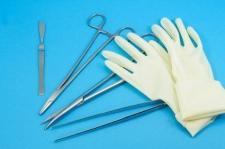Debridement Methods
The four main types of debridement are: autolytic, enzymatic, mechanical and surgical. Each has its own advantages and disadvantages. Let’s take a look at each method individually:
Autolytic debridement
This form of debridement uses the body’s own processes (enzymes and moisture) to break down tough eschar and slough. It does not damage healthy skin, but breaks down dead and devitalized tissue over time quite effectively. The idea is to keep wound fluids in constant contact with the wound. This is achieved with the use of semi-occlusive or occlusive dressings such as transparent films, hydrogels and hydrocolloids. This method can be used on stage ll or lll wounds that are not heavily exudative.
Advantages
- no damage to surrounding skin; is selective for necrotic tissue
- the process is safe because it uses the body’s natural processes to rid the wound of necrotic tissue
- it is easy to perform
- very effective
- not painful for the patient
Disadvantages
- the process takes time (may take days to weeks)
- the wound must be routinely monitored for signs of infection
- anaerobic growth may occur when an occlusive dressing is chosen
Enzymatic debridement
This form of debridement utilizes chemical agents to break down necrotic tissue. They are most useful for wounds with a large amount of necrotic or eschar formation.
Advantages
- work faster than autolytic debridement
- if properly applied, there is little risk to healthy tissue
Disadvantages
- the patient must have the chemical agent prescribed and it may be fairly expensive
- care must be taken to ensure healthy tissue does not come in contact with the chemical agent
- a secondary dressing may be required to absorb exudate
- chemical debridement may cause some discomfort to the patient (i.e., burning sensation, increased wound pain)
Mechanical debridement
This is one of the oldest forms of debridement. This method uses a procession of moist to wet dressings, which are then manually removed. This causes non-selective debridement of necrotic tissue and slough (and sometimes healthy tissue as well). Hydrotherapy, in which the patient soaks in a whirlpool tub, can also be considered a form of mechanical debridement. Mechanical debridement is best suited to wounds with large amounts of necrotic debris.
Advantages
- cost-effective due to the fact that gauze is the material used
- dressing changes are simple so the patient can be taught to change their own dressing
Disadvantages
- may remove healthy (healing) tissue as well as devitalized tissue
- time-consuming as the dressings must be changed often (or the patient must spend a lot of time in the whirlpool bath to achieve the desired goal)
- can be quite painful for the patient
- infection is a risk when whirlpools are used due to waterborne contamination
Surgical debridement
This form of debridement uses sharp instruments (such as a scalpel) or a laser to remove necrotic tissue, either at the patient’s bedside or in an operating room under general anesthesia. This method is best for very large wounds with a lot of necrotic material and infected material.
Advantages
- excellent control over what and how much tissue is removed
- fastest way to achieve a clean wound bed
- can speed the healing process
Disadvantages
- not cost-effective if an operating room is required
- general anesthesia carries its own risks
- is painful for the patient
These methods are the common methods of debridement available today. In deciding which method is best for your patient, a careful weighing of advantages and disadvantages is necessary. Almost all of these methods can be painful, therefore pain control should also be factored in to your decision.
Note: A fifth type of debridement is biological debridement using maggots that have been grown in a sterile environment. The maggots eat only necrotic tissue, thus this type of therapy can be thought of as selective. This method is gaining in popularity, but some patients find the method somewhat painful and their squeamishness may stand in the way of using this method of debridement.
For information on wound care education, consider becoming wound care certified. WoundEducators offers 100% online wound care certification courses for healthcare professionals of all levels.
Source:
Moore, Zena (2012). The important role of debridement in wound bed preparation. Wounds Internationsal, volume 2 issue 2. http://www.woundsinternational.com/pdf/content_10389.pdf


to be enroll and get a certification, wonder what are the requirements, myself, studying to take the National Board Teste of Medicine (USMLE),planing to be as a voluntaree at the WMMC on june to rotate in all the services and motivate myself to keep going to the end.. Thanks all your, gmg.
For detailed information visit our wound care certification courses page, or contact us directly.